The early childhood education and care sector consists primarily of two types of programs: childcare services and preschool services. In addition to these services, there are also other programs such as playgroups which are mostly run by respective state/territory playgroup organisations. The type of program a child is enrolled in is based on a family’s economic needs, age, and the developmental needs of the child. This sector plays an important role in children’s development from birth to the age of 12. It prepares children for the school years ahead through the development of their physical, emotional, cognitive, language and communication skills. The sector also lays the foundation for social competence, literacy and numeracy acquisition, problem-solving skills, and general knowledge in the early years of a child’s life.
The industry generates over $360 billion in revenue annually, which constitutes 9% of Australia's Gross Domestic Product (GDP). The share of the construction industry's contribution to the GDP makes it the third largest sector in Australia. For the past 5 years (2015-2020), the industry at the national level has experienced a decline in construction activities. The decrease in the contribution of the industry has mainly been caused by a steady downturn in residential buildings, a fall in mining investments and reduced government spending on heavy and civil engineering projects. These projects include power generation capacity, water supply resources and others. However, the sector's contribution to the GDP is projected to increase by 2.4% annually over the next 5 years. In terms of employment, the Australian construction industry employs approximately 1.2 million people, which is 9% of the national workforce. Since 2015, employment numbers have fallen, nevertheless, projections from the Australian Bureau of Statistics (ABS) show a projected growth of about 80,000 workers by 2025. The growth of the construction industry's employment in the future is linked to an expected increase in demand for housing, commercial buildings, social spaces, and infrastructure as Australia's population grows. The Federal and state/territory governments' commitment to increase infrastructural investment to catch up with the infrastructure backlog will also create further demand for construction workers.
Children who have good early childhood experiences before age 6 in a stimulating, nurturing environment have better outcomes throughout their life…better school grades, better self-esteem, fewer social problems and are less likely to be teen parents, use drugs and be involved in crime.
Clyde Hertzman, 2003
Types of Services
The construction industry, based on ABS categorisation, broadly comprises 3 sub-sectors. These are; building construction, heavy and civil engineering construction, and construction services.
- Long Day Care: Long day care is a form of centre-based care that provides all-day or part-time quality care by qualified educators and teachers primarily for children from birth to five years old
- Family Day Care: Family day care offers quality home-based care services in small groups for children from birth to 12 years of age
- In-Home Care: In-home care is a flexible form of childcare services which involves the provision of quality care services by a qualified educator or teacher in a child’s own home
- Outside School Hours Care: Outside school hours care provides an opportunity for children over preschool age to relax and play in a supervised environment either before or after school
- Occasional Care: Occasional care offers education and care services on an ad-hoc or ongoing basis for children primarily under school age
- Vacation Care: Vacation care provides quality education and care services for school-aged children during the school holidays
- Preschool:
Preschool services deliver structured play-based learning programs by a qualified teacher for children in the year or two before full-time schooling.
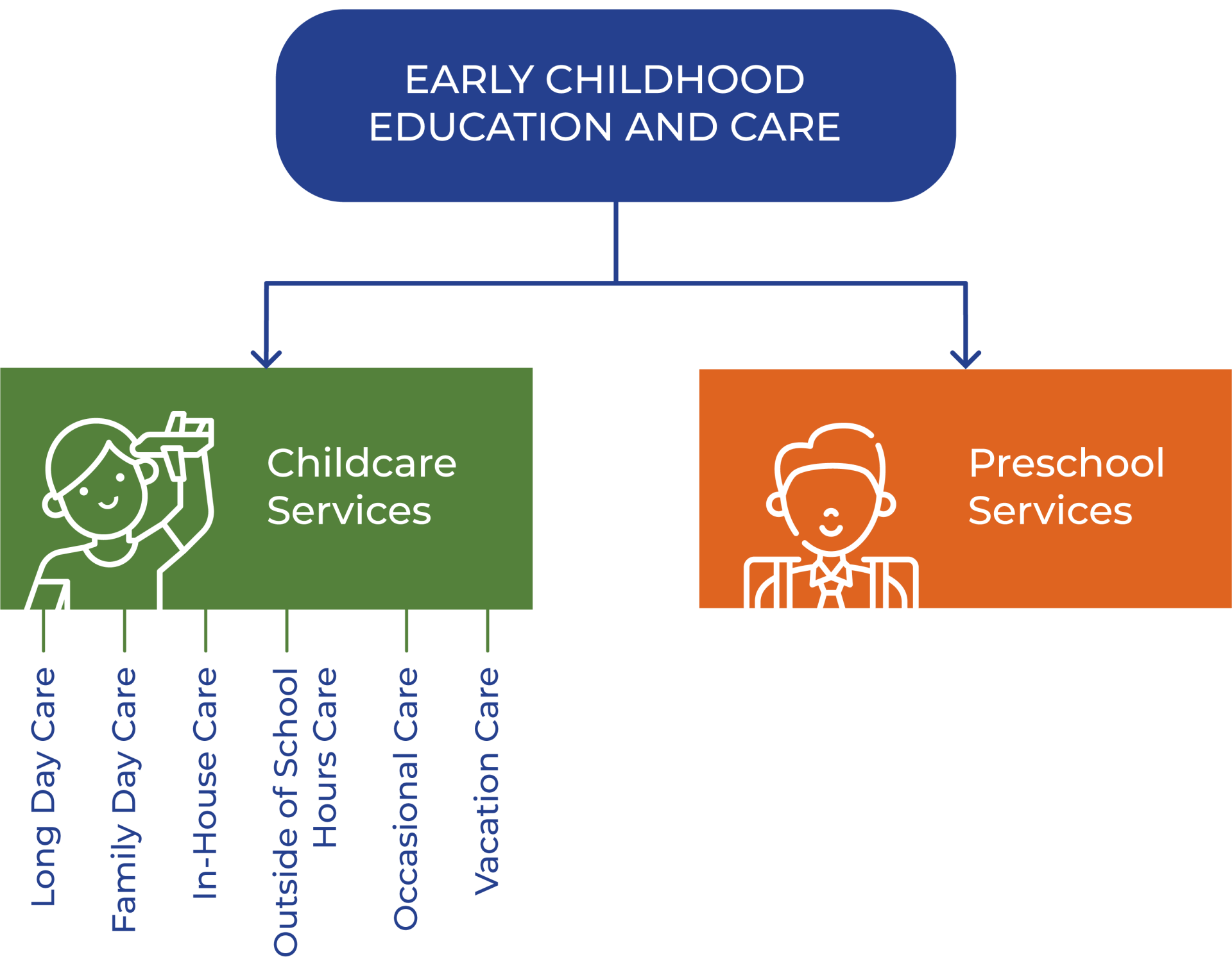
Having nurturing, warm and attentive carers is the most critical attribute of quality in any child care setting, especially for younger children.
Productivity Commission, 2014
Qualification Requirements
The quality of the services within the sector is highly dependent on a trained, skilled, and qualified workforce. As a result, through the Australian Children’s Education and Care Quality Authority (ACECQA), the sector has clearly defined the minimum qualification requirements to work in the field, and this is outlined in the National Quality Framework (NQF). These qualification requirements vary across all types of care services.
Source: Australian Children’s Education and Care Quality Authority (ACECQA), 2018
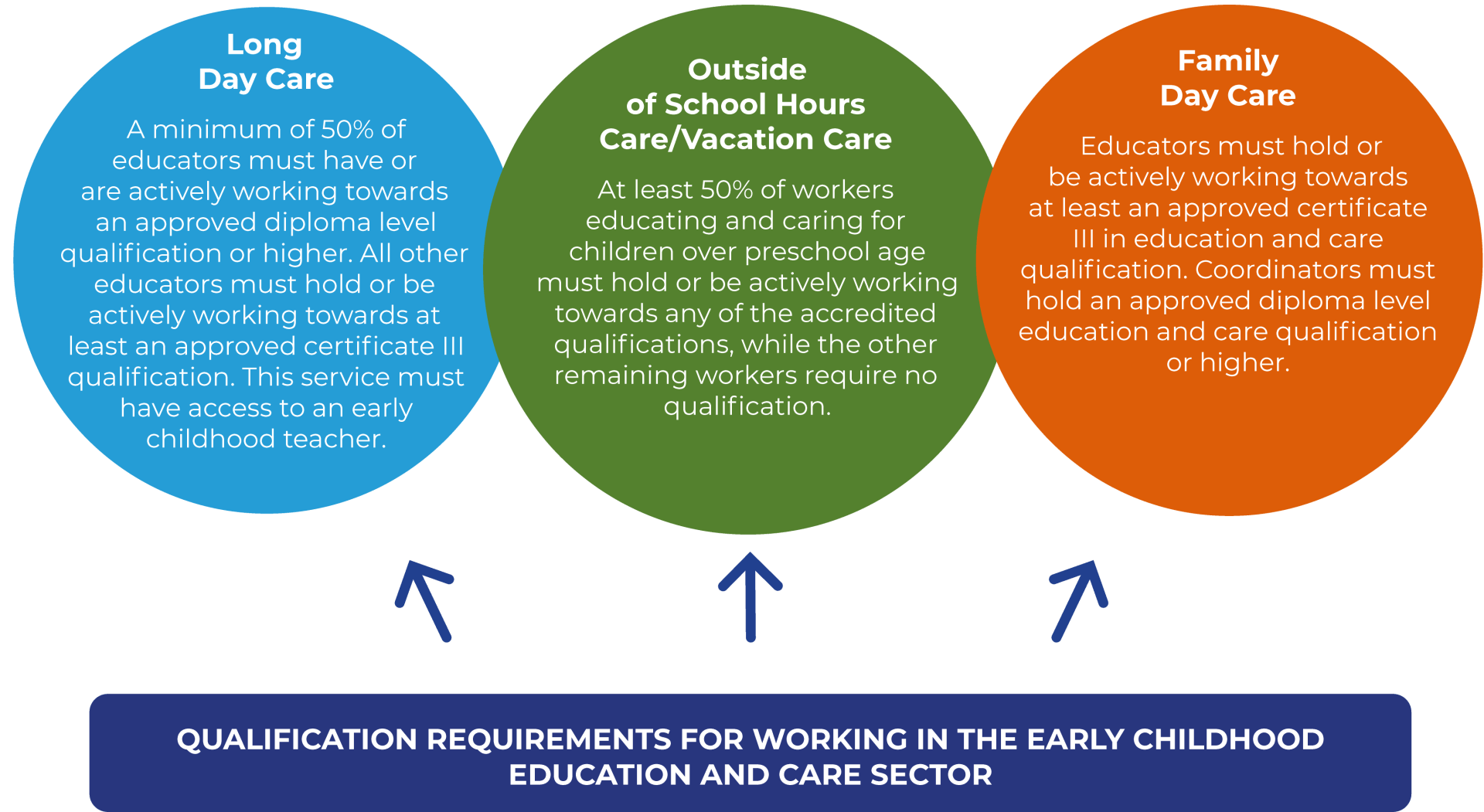
MAIN LEGISLATIONS BEHIND THE SECTOR
Source: Australian Children’s Education and Care Quality Authority (ACECQA), 2018, Northern Territory Government 2020, and Australian Government Department of Education Skills and Employment 2020

Educator to Child Ratio
Educators and teachers play a crucial role in the provision of quality early childhood education and care services. The educator-child ratio is a major factor that influences the effectiveness of early childhood education and children’s development. It is generally believed that a ratio of an educator to fewer children is an indication of more quality one-to-one time with children. A lower educator-child ratio also reduces stress and provides educators with ample time to complete mandatory documentation and pursue professional development courses. In the NT, there are different educator-child ratios across the various age groups and care service types. The following provides a summary of the NT’s educator-child ratio:
Source: Australian Children’s Education and Care Quality Authority (ACECQA), 2018
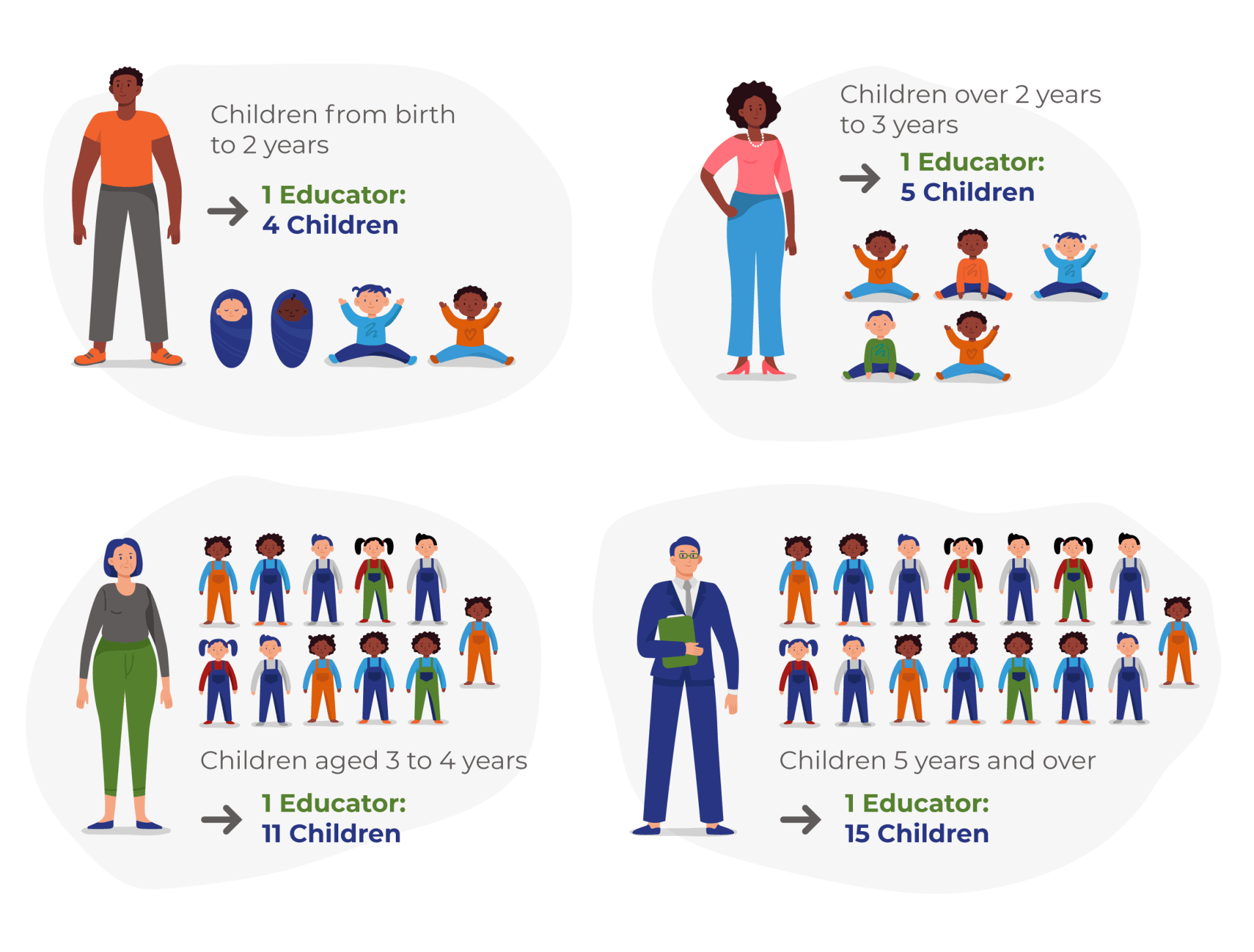
Accessibility to Services
The quality of the services within the sector is highly dependent on a trained, skilled, and qualified workforce. As a result, through the Australian Children’s Education and Care Quality Authority (ACECQA), the sector has clearly defined the minimum qualification requirements to work in the field, and this is outlined in the National Quality Framework (NQF). These qualification requirements vary across all types of care services.
NUMBER OF NATIONAL QUALITY FRAMEWORK APPROVED CHILDCARE PLACES AND CHILDREN POPULATION 2020
Source: ACECQA, Quarter 1 2020 and ABS, Estimated Resident Population By Single Year Of Age, Northern Territory CAT No. 3101.0, June 2019
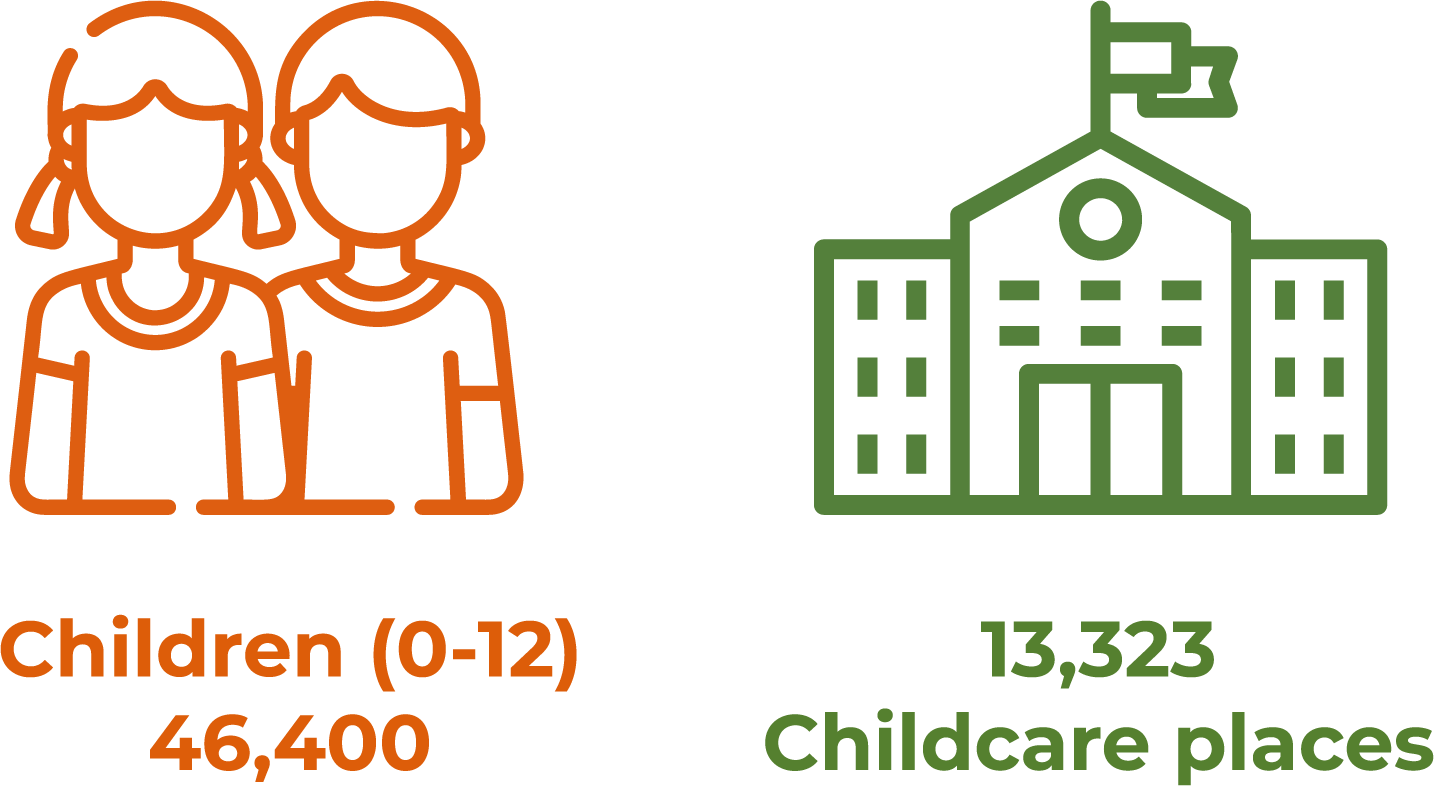
Types and Distribution of Services
Access to early childhood education and care services in principle is open to all children in the NT. While there is no statutory obligation for families to access childcare and preschool services, primary school attendance is compulsory at the age of six. Children in the NT mostly commence preschool when they are four years old and primary school at the age of five for those born before the 30th of June in any given year. There are two broad categories of care services in the NT, the National Quality Framework (NQF) regulated services and the Community Child Care Funded (CCCF) services formerly known as budget-based funded programs.
The NQF regulates the approved early childhood services while the CCCF programs are services that contribute to better education and care outcomes, however, do not meet the NQF requirements. CCCF programs are mostly located in remote and very remote places where services may not otherwise be provided. The sector is highly regulated, which requires a highly trained workforce with extensive skill levels to keep up with the ever-changing sector.
NUMBER OF NATIONAL QUALITY FRAMEWORK APPROVED SERVICES IN THE NT
Source: Australian Children’s Education and Care Quality Authority (ACECQA), Quarter 1 in 2014-2020

Source: Australian Children’s Education and Care Quality Authority (ACECQA), Quarter 1 for 2014-2020 and Australian Bureau of Statistics (ABS), 2019.
Region and area classification
Darwin Region
Area classifications: Outer regional, remote, and very remote

Number of NQF approved providers in 2020
39 Preschools
67 Long Day Care Centres
43 Outside of School Hours Care
2 Family Day Care Organisations
1 Other
Region and area classification
- Number of children (0-4): 11,658
- Number of places: 4,222
- Ratio of children to available long day care places: 3:1
Region and area classification
East Arnhem Region
Area classifications: Very remote

Number of NQF approved providers in 2020
7 Preschools
3 Long Day Care Centres
2 Outside of School Hours Care
Region and area classification
- Number of children (0-4): 892
- Number of places: 211
- Ratio of children to available long day care places: 4:1
Region and area classification
KATHERINE Region
Area classifications: Remote and very remote

Number of NQF approved providers in 2020
3 Preschools
6 Long Day Care Centres
4 Outside of School Hours Care
Region and area classification
- Number of children (0-4): 2,078
- Number of places: 280
- Ratio of children to available long day care places: 7:1
Region and area classification
BARKLY Region
Area classifications: Very remote

Number of NQF approved providers in 2020
3 Preschools
1 Long Day Care Centre
Region and area classification
- Number of children (0-4): 679
- Number of places: 50
- Ratio of children to available long day care places: 14:1
Region and area classification
ALICE SPRINGS Region
Area classifications: Remote and very remote

Number of NQF approved providers in 2020
12 Preschools
13 Long Day Care Centres
6 Outside of School Hours Care
1 Family Day Care Organisation
1 Other
Region and area classification
- Number of children (0-4): 2,865
- Number of places: 632
- Ratio of children to available long day care places: 5:1
Early childhood education and care services must be readily accessible to families regardless of their ability to pay or their employment circumstances.
Productivity Commission, 2019
Other Early Childhood Education and Care Programs
Playgroups are an important aspect of the early childhood education and care sector in Australia. Playgroups bring children below school age and their parents or carers together to socialise, play and learn in a fun environment. It has been in existence for many decades in two main forms, community and supported playgroups. While community playgroups are usually initiated and managed by parents and/or caregivers, the supported playgroups are led by a paid facilitator who is a trained early childhood educator or teacher to assist in the development of children and parent’s wellbeing. Playgroups are run across the Territory to supplement and ensure an even distribution of early childhood education and care programs.
Playgroup NT has the mandate to deliver a fun-based educational experience for children and their parents/caregivers. In addition to this, they provide information and support networks across the NT. The Department of Education also offers child and family integrated services for families and children before birth to the age of five within the community, alongside widely recognised playgroup programs such as Family as First Teachers (FaFT). The FaFT program primarily specialises in delivering early childhood education for families in remote and very remote areas. All playgroups have different target groups, however, they are all geared towards bringing children and their families together as well as holistically improving the children’s wellbeing across all regions of the Territory.
PLAY GROUPS ARE DISTRIBUTED AS FOLLOWS ACROSS THE NT
- Darwin region: 19 Playgroup NT Programs; 16 Family as First Teachers; 3 Child and Family Centres
- Alice Springs region: 3 Playgroup NT Programs; 9 Family as First Teachers; 2 Child and Family Centres
- Barkly Region: 0 Playgroup NT Programs; 8 Family as First Teachers; 0 Child and Family Centres
- Katherine Region: 1 Playgroup NT Programs; 13 Family as First Teachers; 1 Child and Family Centres
- East Arnhem:
3 Playgroup NT Programs; 9 Family and First Teachers
The provision of high-quality and innovative early childhood education and care services grows resilient children and can deliver 13% per year on investment over a lifetime.
James Hackman, 2012
Quality Services
Early childhood education and care services in Australia are assessed and rated to ensure consistency with the National Quality Framework (NQF). Respective state/territory regulatory authorities conduct assessments, and in the case of the NT, the Quality Education and Care NT is responsible. The evaluations of the care providers are based on the National Quality Standard, which has seven quality areas or criteria. Early childhood education and care providers are given an overall rating based on the assessment results. A skilled workforce is necessary to achieve the seven national quality standard criteria, which means that significant investment needs to be in place to ensure any skill gaps are eliminated.
OVERALL ASSESSMENT OF SERVICES IN 2019-2020
Source: Australian Children's Education and Care Quality Authority (ACECQA), Q3, Q4 2019 and Q1, Q2 2020
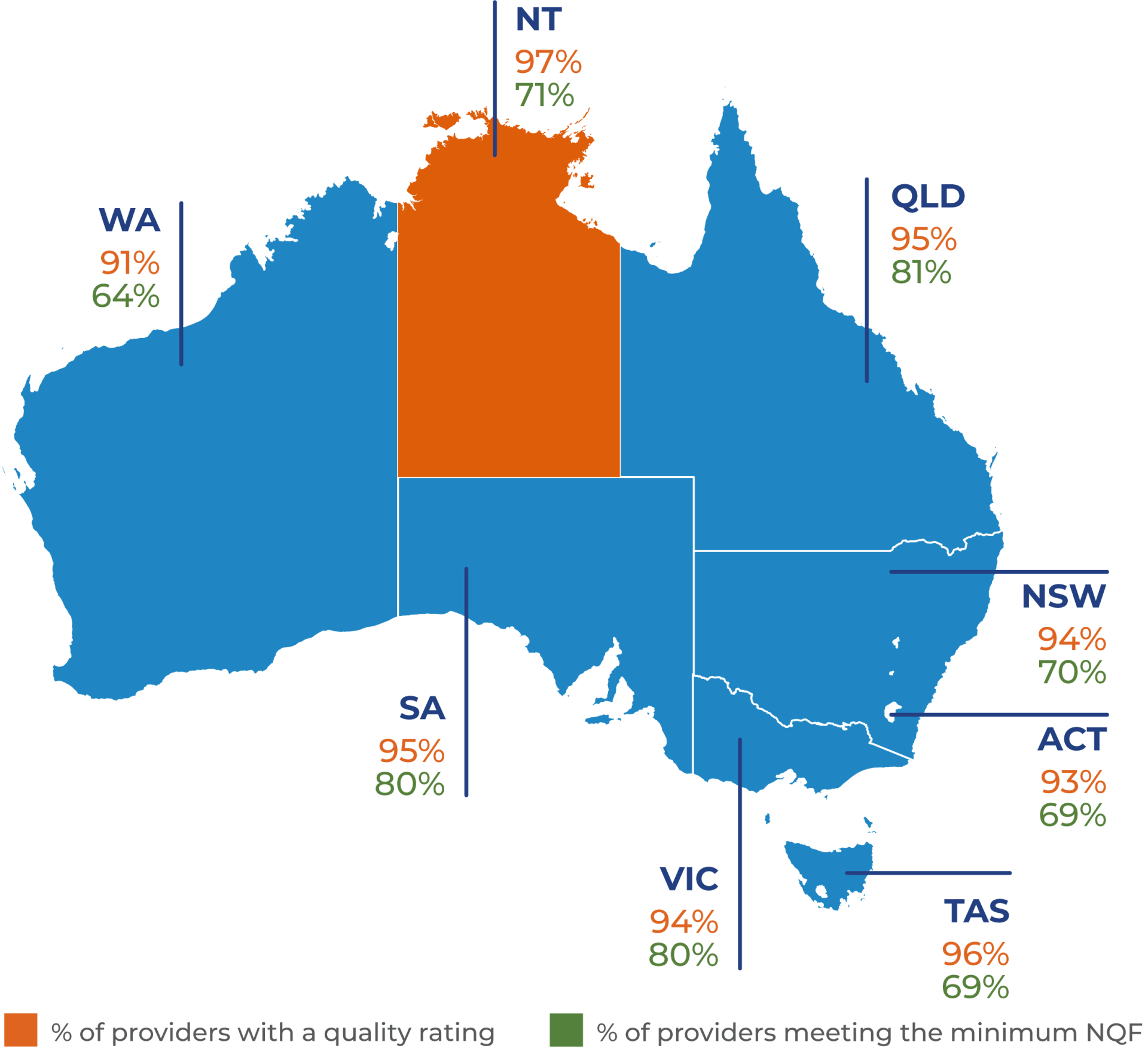
CRITERIA FOR NATIONAL QUALITY FRAMEWORK (NQF) ASSESSMENT
Source: Australian Children’s Education and Care Quality Authority (ACECQA), 2018

rating FOR NATIONAL QUALITY FRAMEWORK
Source: Australian Children’s Education and Care Quality Authority (ACECQA), 2013-2020

Management of Early Childhood Education and Care Services
Early childhood education and care services are managed either by the state/territory government, catholic schools, independent schools, or private individuals and organisations (private for-profit and private not for profit). In the NT, the management of government-owned early childhood education and care services is vested in the hands of regional councils. While most childcare services since 2014 in the NT have been controlled and managed by private for-profit and private not for profit operators, the government have also managed the highest proportion of preschool services.
MANAGEMENT TYPES IN THE NT IN 2020
Source: Australian Children’s Education and Care Quality Authority (ACECQA), 2020

Usage of Services
Source: Australian Bureau of Statistics, 2019 and Department of Education and Training, 2018

FAMILIES UTILISING CHILDCARE SERVICES IN 2018
Source: Australian Children’s Education and Care Quality Authority (ACECQA), 2020

AVERAGE WEEKLY HOURS USED PER CHILD BY SERVICE TYPE
Source: Department of Education, Skills and Employment. December Quarter 2018
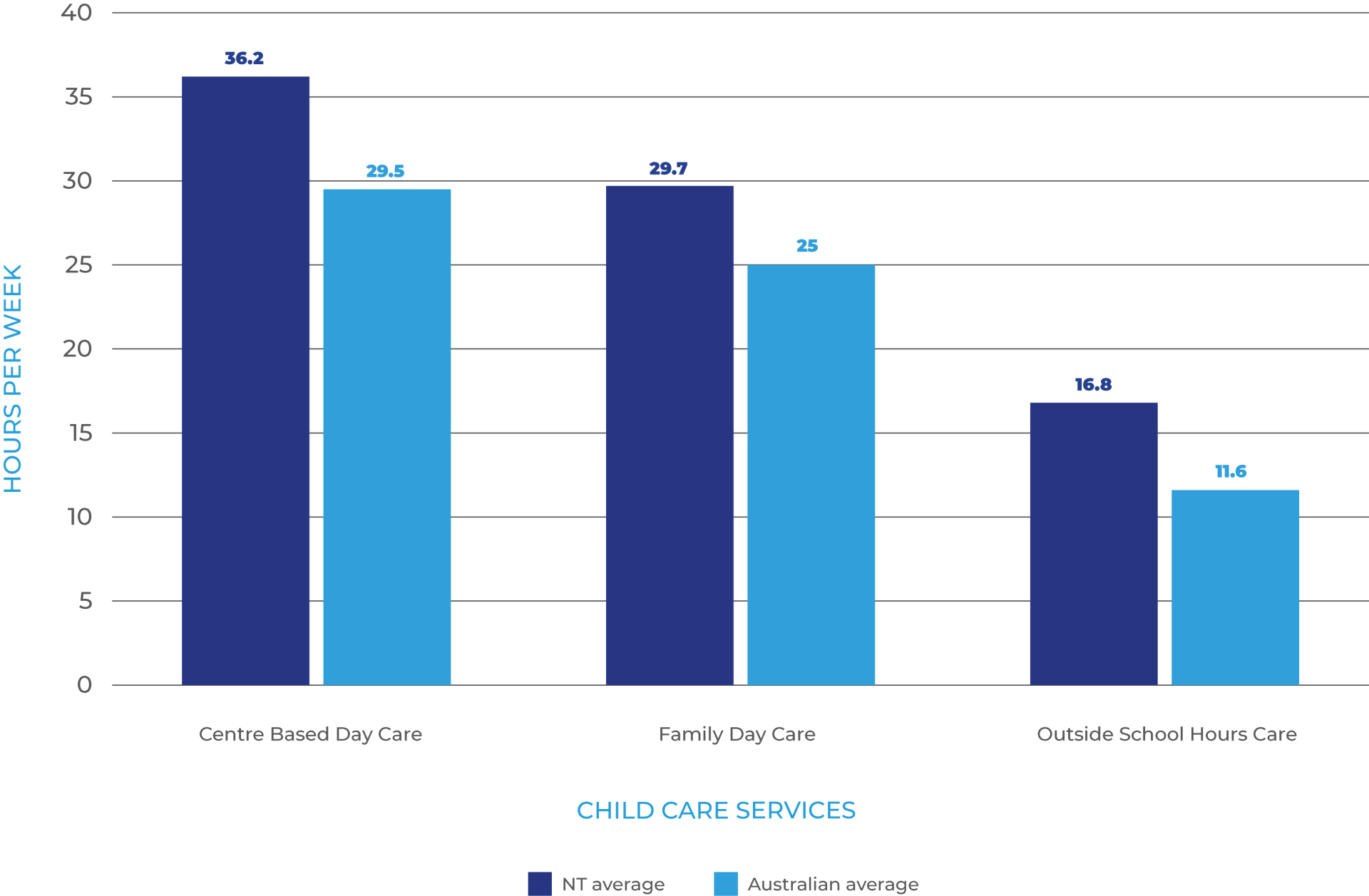
AVERAGE HOURLY COST BY SERVICE TYPE PER CHILD
Source: Department of Education, Skills and Employment. March Quarter 2019
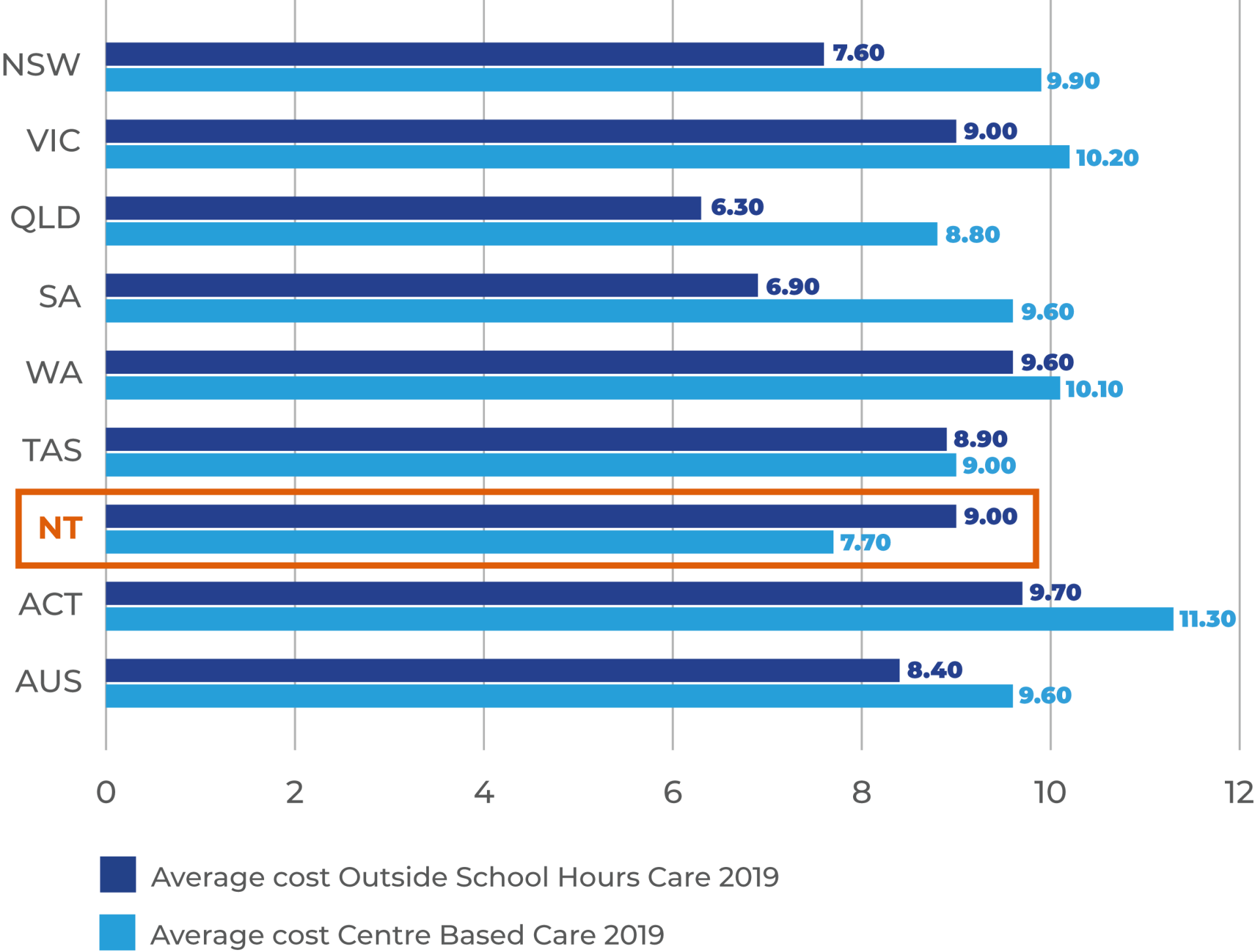
Investment in early childhood education and care provides an equal opportunity to set all children up for a successful future. Every dollar spent on quality early childhood education and care programs yield a $7 to $8 return to individuals and society compared to 45 cents for every dollar spent on youth job training.
Northern Territory Early Years Strategic Plan 2016-2020
Usage of Services
High-quality preschool education has been a long-standing priority of the Northern Territory Government (NTG). It is a fundamental step in children’s development and lays a strong foundation for subsequent school years and future development. To improve outcomes and achieve higher enrolment rates, the NTG in an agreement with the Federal Government signed the first National Partnership Agreement on Universal Access to Early Childhood Education in 2009. In the agreement, the NT is to achieve a minimum of 95% enrolment for children in the year or two before full-time school. The enrolment targets among Aboriginal and Torres Strait Islander children in the NT have still not been achieved, however, there has been significant progress made particularly among other Australian children in terms of enrolment and attendance.
INDIGENOUS AND NON-INDIGENOUS ENROLMENT AND ATTENDANCE IN PRESCHOOL IN THE NT IN 2019
Source: Productivity Commission, 2019
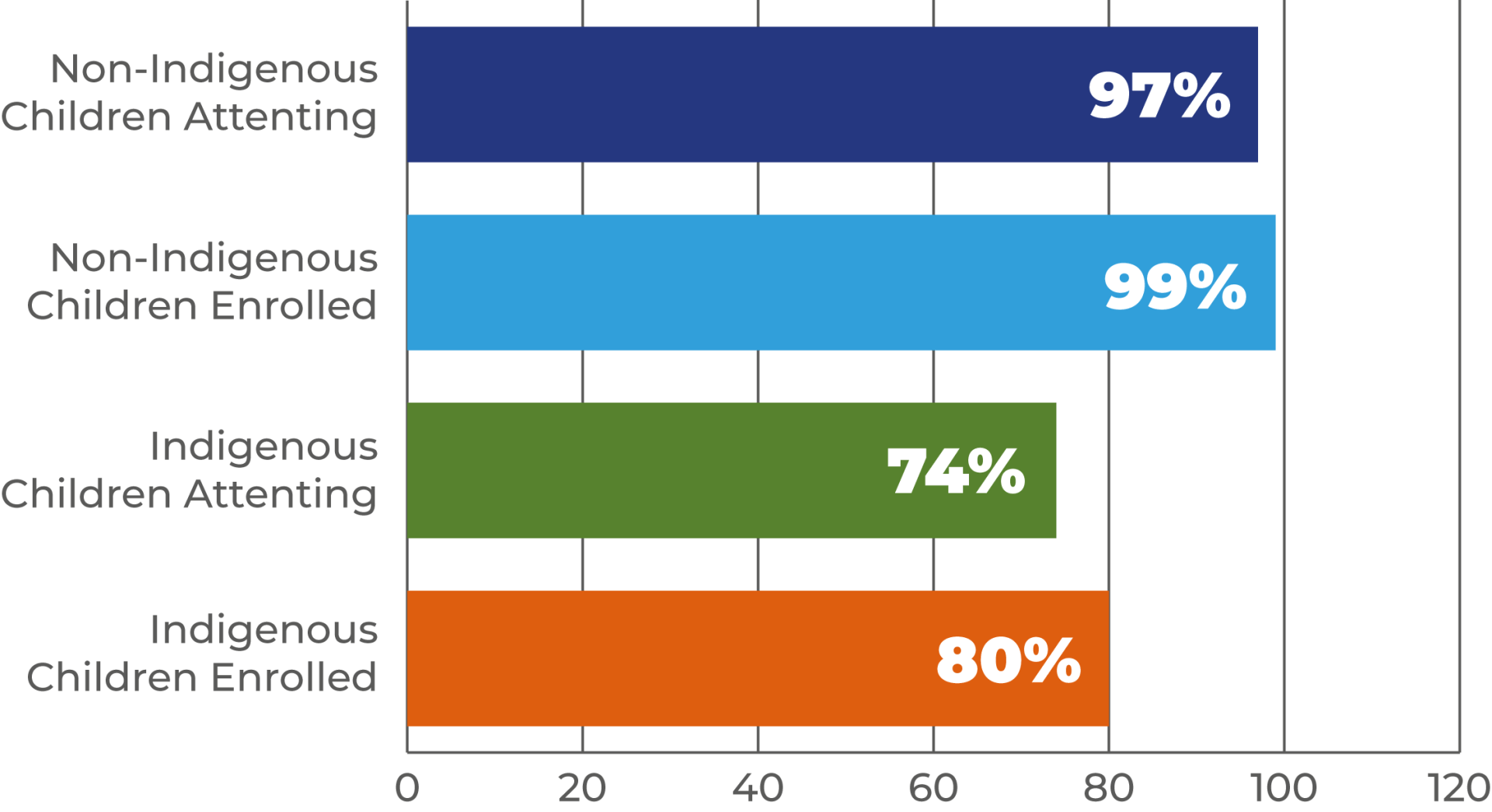
Impact of COVID-19
The COVID-19 pandemic, since its outbreak, has disproportionately impacted all industries, including the early childhood education and care sector. To support families and keep the sector vibrant during the COVID-19 crisis, the Commonwealth Government announced the free childcare program on the 2nd of April 2020. Most stakeholders welcomed the new initiative because of its inherent strengths of resolving some of the sectors complex issues. Although most stakeholders welcomed the new initiative, some stakeholders in the NT were uncertain of the content and the operational features of the program at the initial stages. Peak bodies were helpful in giving guidance during those stages. Industry Skills Advisory Council Northern Territory’s (ISACNT) consultation with some providers revealed a significant increase in enrolment numbers and hours during the implementation of the free childcare initiative in the NT. For instance, several providers reported a sudden change of many children’s attendance from part-time enrolment to full-time with the inception of the government’s program.
However, the free childcare program created challenges for most providers in the sector. One of the major setbacks of the free childcare initiative was the imposition of severe financial hardship on service providers. This was due to the government only covering part of the childcare fees. It was also found that excessive losses of weekly income for some care providers triggered the reduction of rostered hours of many childcare workers. This was particularly the case with skilled migrants and other care workers who were attached to schools because these staff members were not eligible for the government’s Jobkeeper incentive. In some scenarios, a few of the service providers completely shut down services because they were unable to cope with the untold financial hardships. Even though many early childhood education and care providers were financially stressed, most instituted measures to ensure ongoing work for their staff which included the utilisation of the Northern Territory Government’s grants. The general and mental health of staff adapting to the new COVID regulations was also a significant impact on the sector.
Government investment in quality early childhood education creates smarter and healthier children and is likely to reduce 8,500 children a year from experiencing obesity-related health issues throughout their lives, 2,300 children are further less likely to become smokers and 763 children are less likely to be incarcerated as adults.
The Front Project, 2020
Average Waiting Time for Childcare Enrolment
Waiting time for families to get their children enrolled in childcare is a critical issue that has gained attention in Australia, including the NT. The time taken to gain enrolment into childcare is a major dimension for measuring efficiency and effectiveness of childcare services. In the NT, the limited number of childcare places coupled with a growing population of children (birth to four) have resulted in waiting lists. Waiting lists exist when childcare service providers make a list of people waiting to access their service, particularly when there are no places.
ISACNT’s engagement with early childhood education and care providers demonstrated that it generally takes a much longer time for children to get enrolment with National Quality Framework (NQF) approved providers in remote and very remote areas compared to outer regional areas. However, the services perceived by the public to be providing excellent services, and those that have higher quality ratings have longer waiting periods than others with a lower quality rating. The Community Child Care Funded (CCCF) providers, on the other hand, did not have long waiting lists in remote and very remote areas.
AVERAGE WAITING TIME TO ENROL CHILDREN INTO CHILDCARE
Source: Productivity Commission, 2019

Industry Intelligence
Limited Territory specific early childhood education and care workforce data coupled with rising labour shortages, workforce attraction and retention issues led to Industry Skills Advisory Council Northern Territory (ISACNT) undertaking an in-depth study of the sector in the NT. ISACNT invited 98 early childhood education and care providers across the Northern Territory, including both NQF approved providers and Community Child Care Funded (CCCF) providers. ISACNT conducted 53 in-depth phone interviews with relevant stakeholders, such as providers, peak bodies, and government departments. The total response rate from early childhood education and care provider interviews was 48%.
Regional response rates
- 43.7% in Darwin
- 100% in East Arnhem
- 28.6% in Katherine
- 100% in Barkly
- 62.5% in Alice Springs
Demographic Composition
The Northern Territory’s early childhood education and care workforce has fluctuated for the past decade, with a higher proportion of female workers. One of the significant strengths of the sector in the NT is its youthful and highly skilled workforce. The natural attraction of young people to technology forms a strong basis for the workforce to better respond to sudden changes in the sector, particularly technological integration.
EXPERIENCE OF THE WORKFORCE
Source: ISACNT Field Survey, 2020

WORKFORCE BY CARE TYPE
Source: Early Childhood Education and Care National Workforce Census, 2010, 2013 and 2016

GENDER COMPOSITION OF THE WORKFORCE
NORTHERN TERRITORY
Source: ISACNT Field Survey, 2020

AUSTRALIA
Source: Early Childhood Education and Care National Workforce Census
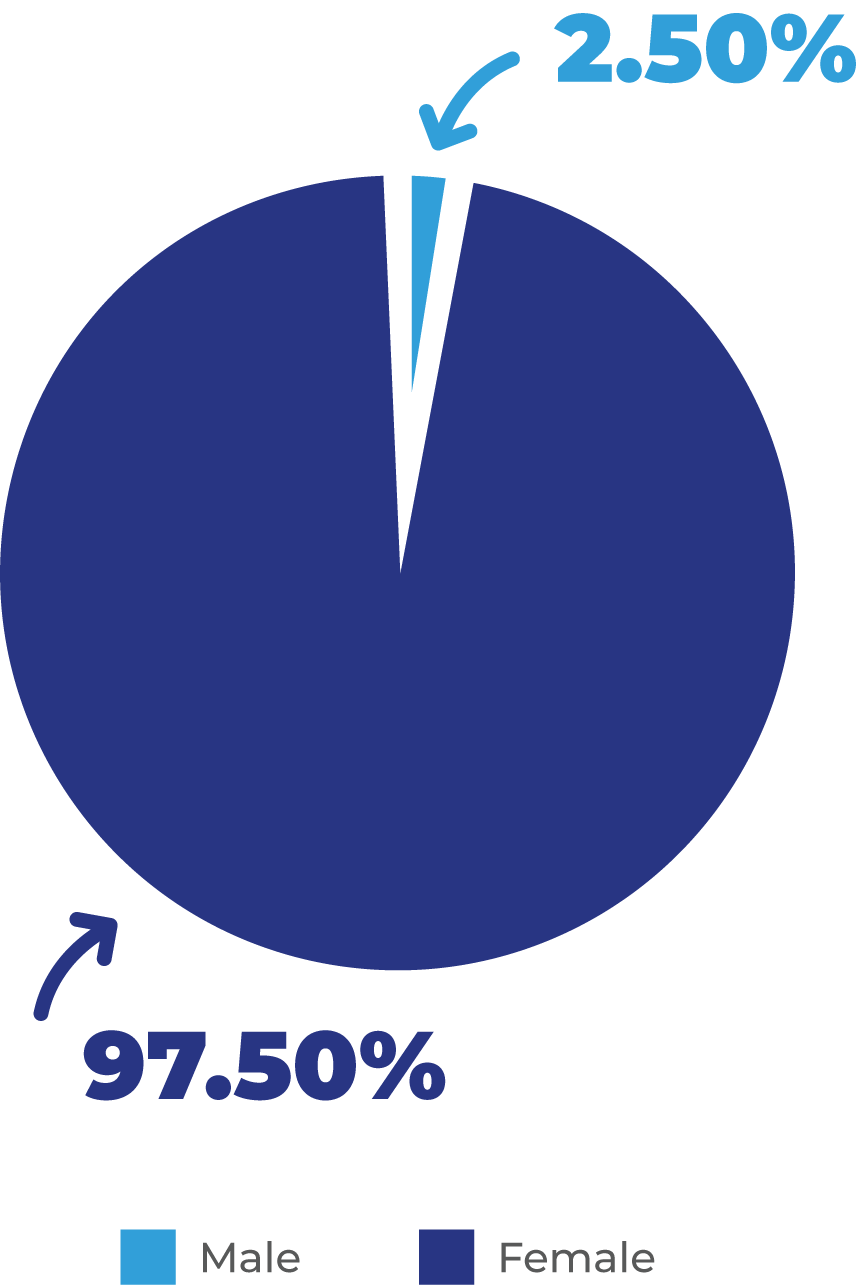
EMPLOYMENT STATUS
Source: ISACNT Field Survey, 2020

AGE DISTRIBUTION
Source: ISACNT Field Survey, 2020

The development and maintenance of a high-quality early childhood education and care workforce is highly dependent on their access to pre-service and in-service training and specialised professional support and mentoring.
Northern Territory Government, 2011
Background of the Workforce
Like elsewhere in Australia, the sector has different cultural and national backgrounds. The sector in the Territory utilises overseas skilled migrants to meet regulatory and operational requirements. This has significant implications on the sustainability and workforce development of the sector in the NT today and in the future.
REGION OF BIRTH FOR OVERSEAS BORN EMPLOYED WORKERS
Source: Australian Bureau of Statistics, 2006 and 2011

INDIGENOUS STATUS OF THE WORKFORCE
Source: Early childhood Education and care National Workforce Census, 2016 and ISACNT field Survey, 2020

Duration for Filling vacancies
Workforce shortages in this sector have been a long-standing challenge in the NT for close to a decade. Although significant progress has been made, there is more room for improvement, particularly in remote and very remote areas. Early childhood education and care providers often encounter difficulty attracting suitable applicants for workforce vacancies. Some of the applicants often lack skills, qualifications or experience to fill an advertised position which often leads to the providers being unsuccessful in filling the vacancy. According to the Department of Jobs and Small Business, in 2018, individuals with a certificate III were in higher demand compared to those with diploma qualifications. Employers seeking certificate III qualified childcare workers experienced greater difficulty filling the vacancies. However, in recent consultations by ISACNT, it was found that employers found it more difficult filling vacancies that require a diploma level qualification or higher, in comparison to certificate III vacancies. This challenge cuts across all regions in the NT, especially in the very remote areas. The changes of the workforce shortages, from certificate III being in high demand to a diploma, indicate a shift in the demand on the various skills sets and qualifications.
APPLICANTS AND VACANCIES
Source: Department of Jobs and Small Business, 2018

AVERAGE DURATION FOR FILLING VACANCIES
Source: ISACNT Field Survey, 2020
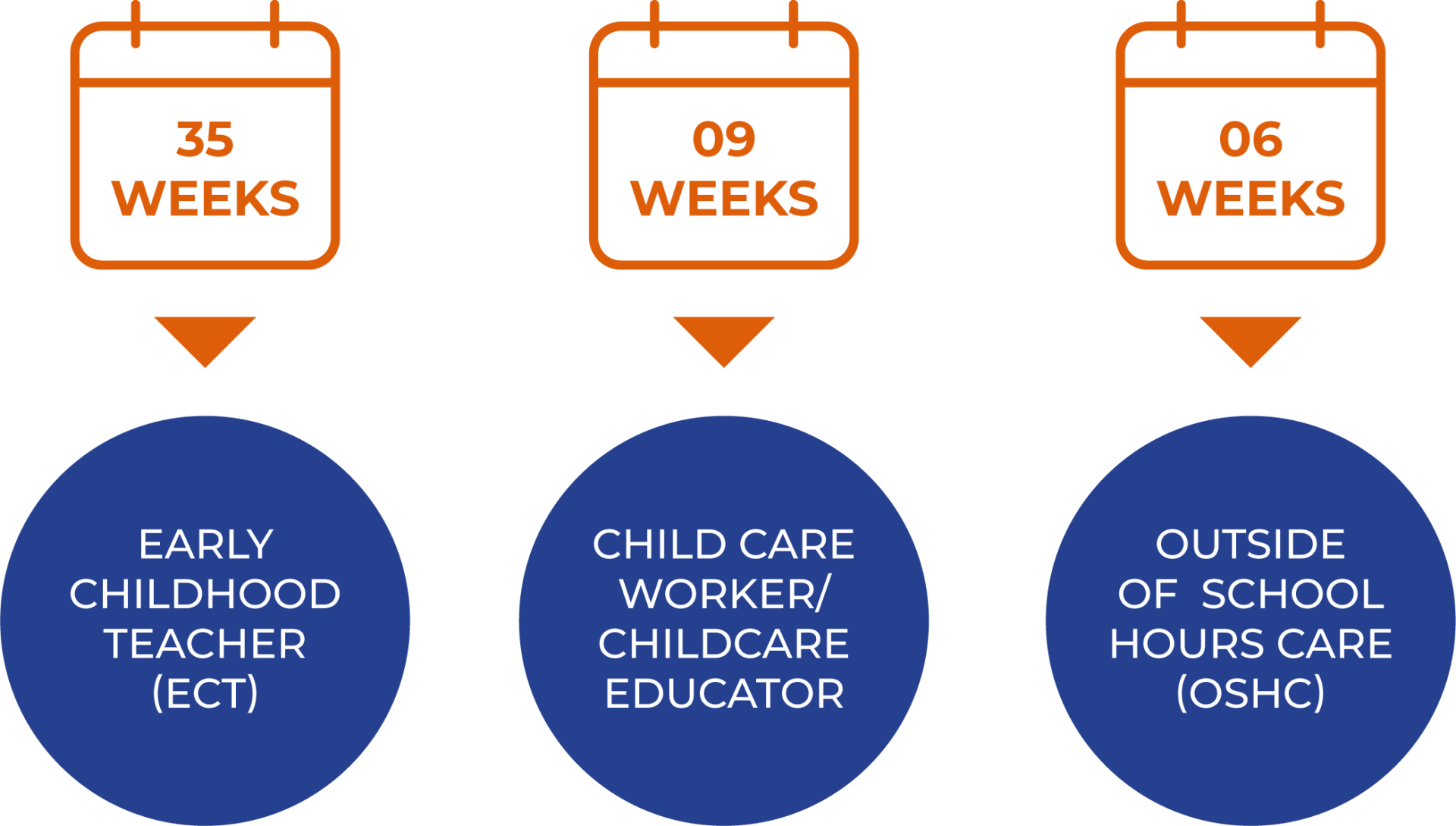
Qualifications of the Workforce
The National Quality Framework (NQF) requires employees to have or be actively working towards an approved qualification in early childhood (a certificate, diploma, or bachelor’s degree). Since 2012, all early childhood education and care providers have instituted measures to ensure that all employees have or are actively working towards a qualification approved by Australian Children’s Education and Care Quality Authority (ACECQA). In 2016, approximately 61% of the sector’s workforce in the NT had a certificate III or higher qualification in either early childhood or closely related fields, while 39% had no relevant qualification but worked based on experience. Data from ISACNT’s consultation with providers revealed that there are more workers with diploma qualifications or are working towards a diploma level qualification in early childhood, than the other levels of qualifications as displayed in the graph.
QUALIFICATIONS OF EARLY CHILDHOOD EDUCATION AND CARE WORKFORCE IN THE NORTHERN TERRITORY IN 2020
Source: ISACNT Field Survey, 2020

Current State
Strenghts
SOCIO-ECONOMIC
- Existence of the National Quality Framework (NQF) and other legal frameworks create a standard approach to regulate early childhood education and care providers to deliver quality services in the Northern Territory (NT)
- Establishment of Quality Education and Care Northern Territory (QECNT) to undertake routine assessments of care providers ensure consistency with NQF
- Routine monitoring and evaluation of providers by regulatory bodies contribute to improvements in the quality of early childhood education and care services
- High proportion of providers in the NT have quality educational programs which facilitate children’s development
- Availability of different types of care services that meet the needs of all families in the NT
- Increasing number of regulatory and compliance requirements in the sector reinforces the safety and health of children
- Waiving or lowering of the NQF requirements for some providers assist in maintaining the service delivery particularly for the NT’s remote and very remote areas
- Availability of grants and funding to early childhood education and care providers for infrastructure expansions and ground upgrades
- Existence of Northern Territory Early Years Strategic Plan to guide the development of the sector and improve children outcomes
WORKFORCE AND OCCUPATION
- Commitment of early childhood education and care workforce and providers to continuously improve upon children’s day-to-day experiences stimulate children’s structural and functional development as well as their intelligence and personalities
- Existence of the Early Years Workforce Strategy at the national level increases awareness and promotes the professionalism of the early childhood education and care workforce
- Existence of a national strategy to support Aboriginal and Torres Strait Islander peoples to build a career in early childhood education and care may reduce the existing workforce challenges in the NT
- Early childhood education and care courses available in the NT provide students/workers placement experiences that enables them to work effectively with other early childhood professionals to develop skills and experience
- Existence of several professional development courses online for care workers in the NT help the workforce to develop their practice
- Strategic location and closeness of NT to other Asia Pacific countries helps to attract skilled migrants with relevant qualifications and experience to meet requirements in a short-term perspective
- Australian Government’s introduction and funding of some short courses in early childhood education and care may encourage more people to pursue a career in the sector which could improve existing workforce challenges in the NT
- Recent review of courses may assist students and workers to be equipped with the right skills that reflect current industry needs
- Availability of traineeships towards qualifications to support both employers and individuals to develop and upskill to ensure regulatory requirements are met
TRAINING AND SKILLS
- Flexibility of numerous pathways into the sector makes it easier for people interested in pursuing a career to acquire skills and qualification
- Inclusion of student placement as part of the early childhood education and care qualifications help students to develop and improve upon their skills in a realistic work environment
- Strong collaboration between some Registered Training Organisations (RTOs) and care providers facilitate skills acquisition of students during placements
- Existence of universities in other Australian states have the resources to deliver postgraduate courses that may absent in the NT
- Government support and funding for some early childhood education and care courses help to increase the workforce with the right skills and qualifications
- Routine monitoring and evaluation of care providers help to identify and bridge the skills/learning needs of staff
- Inclusion of early childhood education and care units as part of the NT government-sponsored courses help to upskill the sector’s existing workforce
- Completion of some relevant early childhood short courses provides students with advanced standing (credit) into certificate and diploma courses in early childhood education and care
- Recent review of the current course units for Certificate III and Diploma of Early Childhood Education and Care may streamline the quality of training
- Funding from both government and sometimes providers for care courses may incentivise students to pursue training in the sector
Challenges
SOCIO-ECONOMIC
- Inadequate number of early childhood education and care providers in very remote areas in the NT affect children’s accessibility to quality services and preparation for primary school education
- Substandard infrastructure of early childhood facilities in some remote and very remote communities hinder the provision of quality services
- Benchmarking government commitment in the provision of childcare services the NT is lower when compared to other states which may affect the equity of access and hinder enrolment numbers
- Increasing demand for childcare care services, especially for children (birth to two years), in the NT and the limited early childhood education and care places impede accessibility to childcare
- Long waiting time for placement in childcare may affect enrolment numbers, children’s development, and parents’ employability
- High cost involved in the establishment and registration of new early childhood services in the NT is not encouraging for new operators to venture in the sector
- Waiving of the NQF requirements for some care providers in the NT may compromise the quality of service rendered
WORKFORCE AND OCCUPATION
- The ongoing occurrence of Early Childhood Teachers (ECT) staying in the sector for some time and then moving on to take permanent positions in primary schools impede the growth of the sector
- Limited presence of Registered Training Organisations (RTOs) delivering early childhood education and care qualifications in remote and very remote communities discourages student’s possibility of obtaining respective qualifications and pursuing a career
- Limited applicants with relevant experience and skills affect the quality of the workforce and make recruitment difficult
- Low completion rates in early childhood education and care programs in the NT compound existing workforce shortages and challenges
- Some qualified workers express unwillingness to work in remote and very remote areas which may further compound existing workforce challenges
- Career development and progression is limited in the sector impeding the desire of some people to pursue a career in the sector
- Ongoing challenges in remote and very remote areas after the introduction of the National Quality Framework (NQF) in 2012 led to the loss of some experienced workforce without a qualification, compounding already existing workforce shortages
- Negative workforce perceptions of long working hours, low wages, and lack of educational awareness campaigns attracting skilled workers specifically in the NT to motivate the youth to obtain a career in the sector may exacerbate existing workforce challenges involving attraction and retention of staff
- Some staff absenteeism and unreliability affect the provision of quality care services in the NT
- Maintaining required educator to children ratio may result in negative pressures from administrative tasks which affect educators and limits quality time spent with the children
TRAINING AND SKILLS
- Limited competition among RTOs delivering courses at the bachelor and higher degree levels may affect workforce development and progression
- Existing courses do not provide educators with the skills in caring and managing the behaviours of children with special needs
- Poor internet connectivity in remote and very remote NT makes it challenging for students/staff to undertake professional development and early childhood education and care courses
- Quality of student assessments, particularly during placements in remote and very remote areas, is often impeded by distance and other critical factors affecting training outcomes and skills acquisitions
- Ongoing annual review of tuition fees for courses may affect providers financial ability to support workers for professional development and acquisition of skills if the fees increase
- Some RTOs are not sufficiently providing the needed support for students during placements which may affect completion rates and the quality of the workforce produced in the NT
- Low literacy and numeracy skills of some students enrolled in care qualifications hinder teaching and learning outcomes
- Shortage of experienced mentors in the sector challenges the level of supervision of students and trainees
- The introduction of certificate III as a pre-requisite for entry into the Diploma of Early Childhood Education and Care may disrupt career progression or hinder people from entering the sector
Future State
Opportunities
SOCIO-ECONOMIC
- Current high-quality early childhood education and care services in the Northern Territory (NT) improve outcomes for vulnerable and disadvantaged children
- NTG’s agreement with the Federal Government through the National Partnership Agreement on Universal Access to Early Childhood Education helps to increase enrolment numbers
- NT and Federal government commitment to continuously support and provide funding for the sector is a bold step towards the target of achieving universal access to high-quality services for all children
- High-quality care services and increased family trust in the sector has resulted in higher enrolment numbers and general workforce participation in the NT
- Expansion of many services to provide both childcare and preschool programs in a single location coupled with extended operating hours makes it suitable for employed parents with many children in different age cohorts
- Government’s involvement in the provision of preschool services particularly in remote and very remote NT increases accessibility to care and results in better children’s outcomes
- Strong commitment by NTG and Federal Government to provide quality care accessible to all children in the Territory improve better learning outcomes
WORKFORCE AND OCCUPATION
- Recognition of prior learning by many RTOs helps early childhood education and care providers to meet the qualification requirements in the NQF
- NT has a highly-trained workforce equipped with relevant knowledge, skills, and attributes to provide quality outcomes to mentor future workforce
- Existence of various career pathways present an opportunity for individuals to choose the most suitable options
- Availability of numerous migration options to attract overseas skilled workers with in-depth experience, skills, and qualifications aid the growth of the sector
- Willingness of many providers in the NT to sponsor skilled migrants is an avenue to address the growing workforce shortage
- Existence of many career opportunities in the NT is an incentive to attract more people to pursue a career in the sector
- Availability of loans such as VET Student Loans and HECS-Help assist students to pay course fees and encourage higher enrolment numbers in the NT
- The Northern Territory Early Childhood Workforce Plan 2011–2021 provides guidelines, initiatives, and the blueprint to develop and increase the workforce
TRAINING AND SKILLS
- Existence of well-established training organisations and trainers with in-depth industry experience within the NT to train students/workers help to meet the increasing skill and occupation challenges of the sector
- Availability of funding for traineeships and apprenticeships in the sector increases workforce numbers in the NT
- Current early childhood education and care courses in the NT provide students with skills that meet the needs of children from diverse social and cultural backgrounds
- Continuous commitment of RTOs to deliver high-quality, relevant, and flexible training may ensure educators qualifications and skills are of high quality, leading to the best possible outcome for children in the NT
- Review of regulatory and legal frameworks at both national and state-level may ensure RTOs deliver courses and training that meet the needs of the sector in the NT
- Introduction of entry certificate III requirements into the Diploma of Early Childhood Education and Care will increase the knowledge and skills levels of workers applying for group/team leader positions, improving the quality of childcare provided
- Increased provider numbers to support and fund professional development courses may improve workers’ skills and result in better outcomes for children
- Shifts of many early childhood professional development courses from face-to-face to online delivery incentivise students/workers in remote and very remote areas to enrol and acquire skills and qualifications
- Increased promotions of short courses may assist students to identify educational opportunities and pathways to a successful career
- Effective collaboration between RTOs and providers may increase the quality of students produced
Threats
SOCIO-ECONOMIC
- Arduous nature of registering and licensing of new early childhood education and care services impede the growth of the sector
- Australian Bureau of Statistics’ predictions demonstrate a growing population of children (birth to 12 years) amidst limited available places may impact enrolment numbers
- Fluctuations in state/federal government annual funding to support the provision of quality care services may hinder the growth of the sector especially in situations where funding decline
- Increasing quality of care services in the NT may result in higher fees which when passed on to families could affect enrolment numbers
- Maintaining affordability of services may be a key challenge for the government with pressures on available funding
- Perceived low valuing and recognition of the sector’s workforce, impede the achievement of NQF requirements which consequently impact the available early childhood education and care places for children
WORKFORCE AND OCCUPATION
- Low remuneration coupled with challenging working conditions of the workforce impedes the retention of an experienced and qualified workforce
- Perception of women naturally predisposed to working in the sector discourages many men to take up a career in the sector, creating gender disparity
- Excessive administrative workload coupled with long working hours increases pressures on staff, resulting in employees turnovers
- High staff turnover sometimes is a disincentive for providers to invest in the development of staff and this affects the ability of workers to become conversant with ongoing changes in the sector
- Public perception and valuing of early childhood education and care workers increases staff turnovers and discourages new workforce entry
- Existing workforce willing to pursue undergraduate and postgraduate studies in relevant early childhood qualifications have limited options which forces skilled workers to migrate to other states
- Student placement of 120 hours and 240 hours as a requirement for the award of Certificate III and a Diploma in early childhood education and care respectively with low wage affect enrolment and completion rates
- Some childcare providers are unable to pay above award wages and therefore have a hard time retaining qualified and experienced staff
TRAINING AND SKILLS
- Low completion rates in early childhood courses in the NT exacerbate existing workforce shortage and hinder the acquisition of relevant skills and qualifications
- Territorians who travel interstate to pursue postgraduate courses in early childhood may not return, affecting the growth of the sector
- Introduction of entry requirements for diploma courses in early childhood education and care may hinder individuals with keen interest to pursue a career in the sector
- Substandard early childhood courses delivered by some RTOs in the NT fail to equip students with the needed skills which may result in longer on-the-job training and orientation
- Delivery of short courses online may compromise the quality of the workforce especially if regulators fail to perform their responsibilities
- Newly reviewed programs are condensed, which impedes the development of sufficient skills and knowledge for a valid assessment decision to be made
- Some RTOs do not provide learning and assessment in a structured work environment and this affects students’ performance and the quality of students’ training
- Government's intermittent support and funding to local RTO’s to deliver training to all regions may affect the training delivery
Skills in Demand
The early childhood education and care sector's job market has changed and is continuously evolving with time. This is driven partly by technological advancements and review of the approved courses delivered. Career progression in the sector requires enrolling and completing in-demand skills to expand knowledge and capabilities. In other words, being equipped with both top and generic skills relevant in the sectors helps one to be competitive in the market. ISACNT’s consultation with key stakeholders in the sector identified the following skills in demand.

Source: ISACNT Field Survey, 2020
Career Pathways for Occupations in Demand

CHILDCARE CENTRE MANAGER
ANZSCO # 134111 Childcare Centre Managers, also known as childcare centre directors plan, organise, direct, control and coordinate the activities of childcare centres and services, including physical and human resources.
Skill Level: 1
Certificate III in Early Childhood Education and Care
Diploma in Early Childhood Education and Care
Bachelor of Education in Early Childhood Education and Care
Master of Teaching in Early Childhood Education and Care
OR
Master of Play Therapy

EARLY CHILDHOOD (PRE-PRIMARY) TEACHER
ANZSCO # 241111 Early Childhood (Pre-primary) Teachers teach the basics of numeracy, literacy, music, art, and literature to early childhood (pre-primary) students and promote students’ social, emotional, intellectual, and physical development.
Skill Level: 1
Certificate III in Early Childhood Education and Care
Diploma in Early Childhood Education and Care
Bachelor of Education in Early Childhood Education and Care
Master of Teaching in Early Childhood Education and Care

PRESCHOOL AIDES
ANZSCO # 422115 Preschool Aides also known as kindergarten assistants, provide care and supervision for children at preschool centres under the direction of Early Childhood (Pre-primary School) Teachers.
Skill Level: 4
Certificate III in Education Support
Certificate IV in Education Support

CHILD CARE WORKER
ANZSCO # 421111 Child Care Workers provide care and supervision for children in programs, such as long day care and occasional care, in childcare centres, hospitals and educational centres.
Skill Level: 4
Certificate III in Early Childhood Education and Care
Diploma in Early Childhood Education and Care

FAMILY DAY CARE WORKER
ANZSCO # 421112 Family Day Care Workers provide care and supervision for babies and children, usually in the carer’s own home and under local government or community-based schemes.
Skill Level: 4
Certificate III in Early Childhood Education and Care
Diploma in Early Childhood Education and Care
Enrolments and Completions
Resources
http://www.earlychildhoodaustralia.org.au/wp-content/uploads/2019/11/ELEB-SOEL-Report-2019-Final.pdf
https://docs.education.gov.au/system/files/doc/other/eccc_in_summary_jun_quarter_2018_0.pdf
https://www.education.gov.au/child-care-australia-report-december-quarter-2018
https://docs.education.gov.au/documents/child-care-australia-report-march-quarter-2019
https://docs.education.gov.au/system/files/doc/other/nwc_national_report_final_0.pdf
https://docs.education.gov.au/system/files/doc/other/ntwd_data_analysis_report.pdf
https://docs.employment.gov.au/system/files/doc/other/421111childcareworkernt_1.pdf
https://www.thefrontproject.org.au/images/downloads/Cost-benefit%20analysis_brochure.pdf
https://www.acecqa.gov.au/sites/default/files/2018-03/Guide-to-the-NQF-4-OpRequirements.pdf
https://www.playgroupnt.com.au/find-a-playgroup-map/
https://www.acecqa.gov.au/sites/default/files/acecqa/files/Reports/2014/ACECQASnapshotQ1_2014_2.pdf
https://www.acecqa.gov.au/sites/default/files/acecqa/files/Reports/2015/NQFSnapshotQ1_2015_2.pdf
https://www.acecqa.gov.au/sites/default/files/2020-05/NQFSnapshot_Q1May2020.pdf
https://www.acecqa.gov.au/sites/default/files/2019-05/NQFSnapshot-Q12019.PDF
https://www.acecqa.gov.au/sites/default/files/2018-05/SnapshotQ12018.PDF
https://www.acecqa.gov.au/sites/default/files/acecqa/files/Reports/2017/NQF_Snapshot_Q1_2017_2.PDF
https://www.acecqa.gov.au/sites/default/files/acecqa/files/Reports/2016/NQF_Snapshot_Q1_2016_2.pdf
https://legislation.nt.gov.au/Legislation/CARE-AND-PROTECTION-OF-CHILDREN-ACT-2007
https://www.education.gov.au/child-care-provider-handbook/family-assistance-law
https://www.acecqa.gov.au/nqf/national-law-regulations/national-law